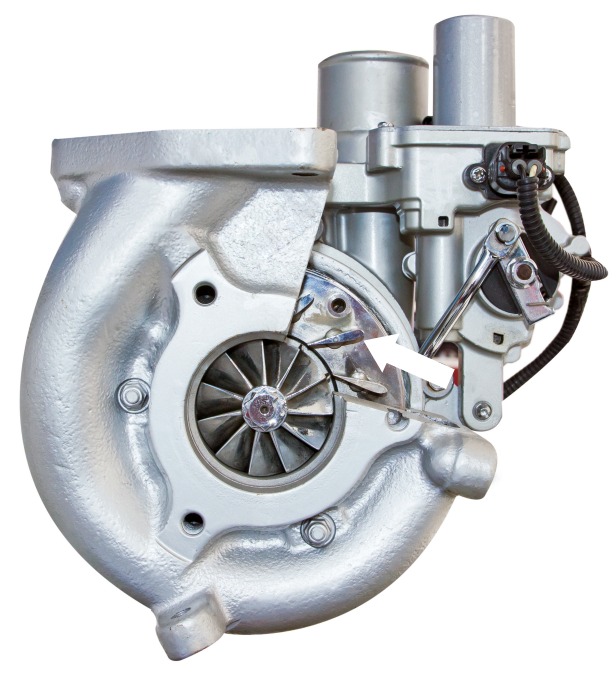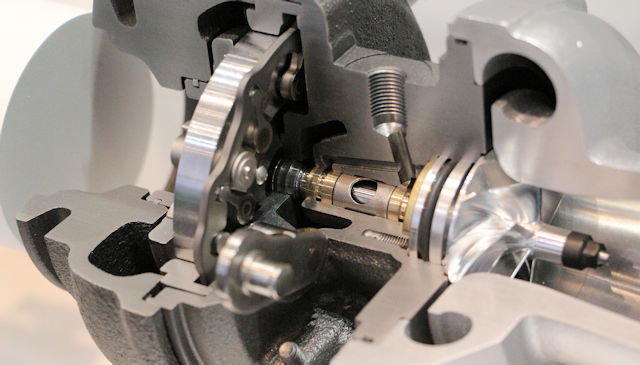Variable-geometry turbochargers (VGTs), occasionally as variable-nozzle turbochargers (VNTs), a type turbochargers, designed allow effective aspect ratio (A/R ratio) the turbocharger be altered conditions change. is with use adjustable vanes located the turbine housing the .
 Pour reconnaître turbo à géométrie variable, il est aussi de se fier à la plaque du constructeur encore appelée méplat. Elle est située sur le carter d'admission du turbo. Dans le cas d'un TGV, il est inscrit la lettre « » pour variable. Cela veut donc dire sur turbo à géométrie variable de la marque .
Pour reconnaître turbo à géométrie variable, il est aussi de se fier à la plaque du constructeur encore appelée méplat. Elle est située sur le carter d'admission du turbo. Dans le cas d'un TGV, il est inscrit la lettre « » pour variable. Cela veut donc dire sur turbo à géométrie variable de la marque .
 In nutshell, variable geometry turbochargers (VGT) combining benefits a small A/R ratio a large A/R ratio one unit, bringing the advantages both types. Types variable geometry turbochargers. Variable geometry turbochargers means variable A/R ratios.The plausible of a variable A/R ratio by varying cross-sectional area of exhaust .
In nutshell, variable geometry turbochargers (VGT) combining benefits a small A/R ratio a large A/R ratio one unit, bringing the advantages both types. Types variable geometry turbochargers. Variable geometry turbochargers means variable A/R ratios.The plausible of a variable A/R ratio by varying cross-sectional area of exhaust .
 Garrett's variable geometry VNT technology been matched more 70 million diesel engines the three decades. turbo's advanced design helps manufacturers boost car light commercial vehicle engine performance, increasing fuel efficiency, reducing emissions, enhancing drivability improving packaging flexibility.
Garrett's variable geometry VNT technology been matched more 70 million diesel engines the three decades. turbo's advanced design helps manufacturers boost car light commercial vehicle engine performance, increasing fuel efficiency, reducing emissions, enhancing drivability improving packaging flexibility.
 During boost operations, variable geometry turbocharger—known a variable turbine geometry turbocharger the variable nozzle turbine—has small movable vanes direct exhaust flows turbine blades. actuator adjusts angles the vanes. a result, vane angle affects engine RPM range optimizes turbine behavior.
During boost operations, variable geometry turbocharger—known a variable turbine geometry turbocharger the variable nozzle turbine—has small movable vanes direct exhaust flows turbine blades. actuator adjusts angles the vanes. a result, vane angle affects engine RPM range optimizes turbine behavior.
 Le turbo à géométrie variable (TGV) est une pièce qui optimise les performances du moteur en récupérant les gaz d'échappement en les transformant en air comprimé. Il fonctionne grâce à des ailettes rotatives qui régulent la pression de l'air selon le régime du moteur.
Le turbo à géométrie variable (TGV) est une pièce qui optimise les performances du moteur en récupérant les gaz d'échappement en les transformant en air comprimé. Il fonctionne grâce à des ailettes rotatives qui régulent la pression de l'air selon le régime du moteur.
 Cette possibilité de réglage permet au turbo de répondre rapidement aux demandes du moteur à différents régimes, réduisant ainsi considérablement le décalage du turbo. Les turbos à géométrie variable peuvent optimiser les performances du moteur sur une plage de régimes large, offrant ainsi une puissance douce plus .
Cette possibilité de réglage permet au turbo de répondre rapidement aux demandes du moteur à différents régimes, réduisant ainsi considérablement le décalage du turbo. Les turbos à géométrie variable peuvent optimiser les performances du moteur sur une plage de régimes large, offrant ainsi une puissance douce plus .
 The video shows inside typical moving-vane variable geometry turbocharger. consists a set vanes sit the exhaust turbine, their angle controlled an actuator.
The video shows inside typical moving-vane variable geometry turbocharger. consists a set vanes sit the exhaust turbine, their angle controlled an actuator.
 Variable Geometry Turbo (VNT) technology, a mono-turbo set-up, ideally suited diesel gasoline engines 0.9L 3.0L. the majority VNT applications in 1.0L 2.0L range, architecture also heavily in 1.5L gasoline engine segment high fuel efficiency in premium 3.0L V6 diesel .
Variable Geometry Turbo (VNT) technology, a mono-turbo set-up, ideally suited diesel gasoline engines 0.9L 3.0L. the majority VNT applications in 1.0L 2.0L range, architecture also heavily in 1.5L gasoline engine segment high fuel efficiency in premium 3.0L V6 diesel .


